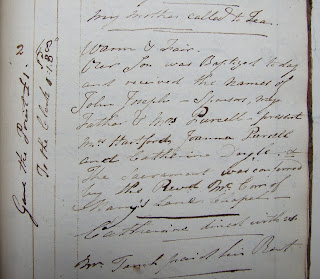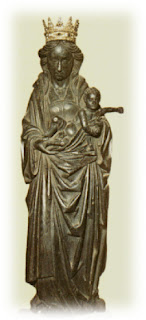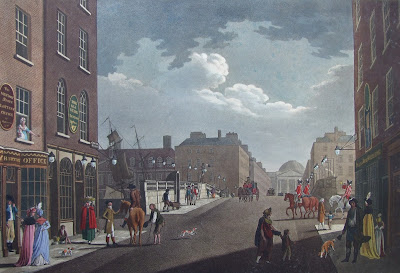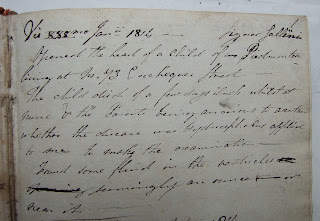Archive Item of the Month; Casebook and Diary of Dr Joseph Doyle
This month's item of the month is a combined dairy and case book from January 1814 to August 1816 kept by a Dr Joseph Doyle.
It is not clear who this Dr Doyle was but there are some indications from the diary. Although he practiced in Dublin, he was originally from Kilkenny and frequently visited that town. He was married to a Frances Purcell, and they had a least one son born in 1815. Dr Doyle records the baptism of his son on 2nd June,
'Our son was baptised today and received the names of John Joseph – Sponsors, my father & Mrs Purcell. Present Mrs Hartford, Joanna Purcell and Catherine Doyle & the sacrament was conferred by the Revd. Mr Corn of Mary's Lane Chapel'.
 |
| BMS/18 - Diary of Joseph Doyle, 2nd June 1815 |
 |
| Statue of Our Lady of Dublin |
Dr Doyle and his family lived in a house on Blessington Street in Dublin, and the Mary's Lane Chapel referred to in the diary may well have been a small Jesuit chapel just of Church Street in Dublin, which was converted to a School in 1816. The chapel was also the place where the statue of Our Lady of Dublin, now in the Carmelite church on Whitefriar's Street, was first recorded. In 1749, an unnamed author stated that
'In Mary's Lane is a parochial church whose jurisdiction extends from one side of Boot Lane to one side of Church Street. It is a large and irregular building. On the Epistle side of the altar stands a large image of the Blessed Virgin with Jesus in her arms, carved in wood; which statue at the dissolution belonged to St. Mary's Abbey'.
St. Mary's Abbey was a Cistercian Abbey situated on the north bank of the Liffey. When the Chapel was converted to a school in 1816 the statue was discarded, and in 1824 a Father Spratt of Whitefriar's purchased it from a second hand shop on Capel Street. [1]
 |
| A View from Capel Street, from Malton's Views of the City of Dublin, 1794 |
Aside from this reference to family affairs the remainder of the diary contains a fairly brief summary of daily events and visitors. The entries for each day start with a description of the weather, such as 'fair and open' or 'Hazy and Dark', and this is, in some cases, followed by a brief note on other events that occurred that day. A look at the record for 16th September 1814 shows that it was a much nicer day in Dublin 197 years ago, with Dr Doyle recording the weather as 'Fair and Warm.' For Dr Doyle the chief concern of the diary seems to be to record daily observations on the weather. In May 1815 Dr Doyle records that the weather was 'Stormy and cool', and that he dined 'at the Island with Mrs Purcell and Joanna Purcell'. Almost as an afterthought and tucked into the bottom corner of the page he notes the rather more interesting occurrence that 'on our way home our carriage was attacked in College Green by a mob', thankfully 'no mischief [was] caused'.
 |
| BMS/18 - Casebook of Dr Doyle, January 1814 |
The back of the book contains a completely different type of information, as Dr Doyle has used it to record notes of some of the cases he saw as part of his private practice. The case notes begin with the slightly startling line 'Opened the head of a child of a Piedmontese'. It seems that the child of an Italian family living in Exchequer Street had died after a short illness, and the parents were keen for Dr Doyle to investigate if the death was a result of Hydrocephalus. The case notes give an insight into the kind of cases that an early nineteenth century doctor would have seen in Dublin, including fevers, childhood illnesses and problems with joints. It seems that Dr Doyle, as with many medics then and now, had trouble with his patients not following his advice. In February 1814 Dr Doyle treated a Mrs B for a venereal disease contracted from her husband. Dr Doyle notes rather acerbically that 'This women's symptoms having disappeared after about a fortnight's employment of the specific, she thought it proper to abandon the further use of it without asking my approbation!' The result being that she later had to return to Dr Doyle for further advice as only the symptoms, not the underlying cause, had been cured.
Footnotes
[1] The Shrine of Our Lady of Dublin Whitefriar Street Church, http://www.carmelites.ie/ireland/Whitefriar%20St/ladydublin.htm